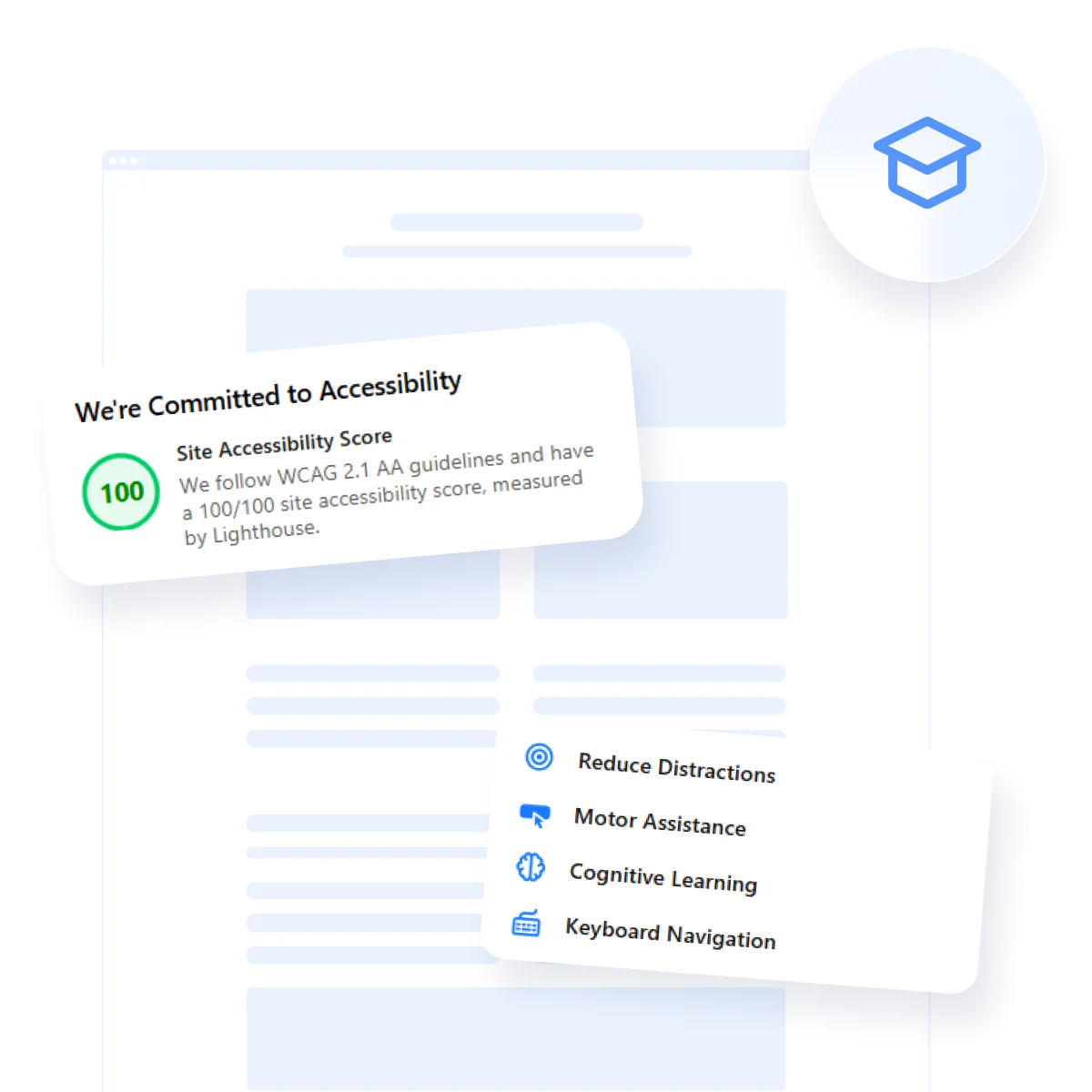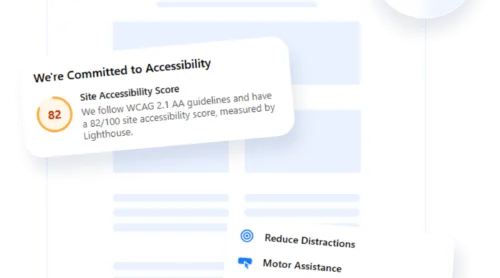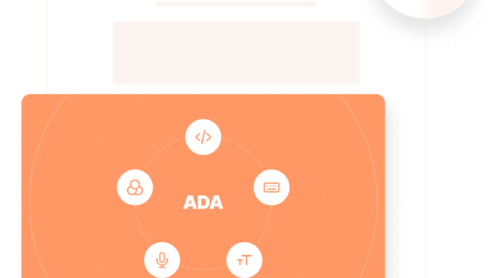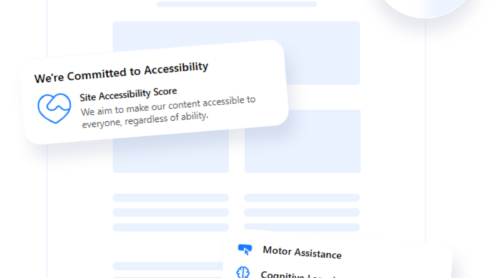In today’s digital-first academic environment, ADA compliance for education websites is no longer a technical afterthought — it’s a legal and ethical requirement. From elementary schools to universities, accessible web design ensures that every student, regardless of ability, can engage with digital content equally.
Accessibility in education websites refers to the practice of designing and developing online resources that are usable by people with a range of disabilities — including visual, auditory, motor, and cognitive impairments. This effort aligns not only with inclusive education values but also with legal standards that govern public and private educational institutions.
For higher education and K–12 institutions alike, accessible websites enable inclusive digital learning that meets the diverse needs of modern student populations. They reduce barriers to information, improve the user experience, and support equal opportunity in academic achievement.
Understanding the legal obligations around digital accessibility is essential — especially as federal enforcement of these requirements continues to increase. This article will walk you through those legal foundations, practical implementation strategies, and actionable steps to help your institution website stay compliant.
Understanding ADA and Legal Obligations
ADA requirements for schools and universities’ websites are rooted in the broader goal of ensuring equitable access to information for all individuals, regardless of physical or cognitive ability. For educational institutions, this means that all public-facing and internal websites must be designed and maintained in a way that does not exclude users with disabilities.
The Americans with Disabilities Act (ADA), enacted in 1990, was initially focused on physical access. However, the rise of digital platforms in education has shifted its enforcement to include digital content. Today, failure to make web-based content accessible can be considered a violation of the ADA.
There are two key sections of the ADA that apply:
- Title II. Covers public institutions, including public schools, community colleges, and state universities. These organizations must ensure that all programs, services, and activities — including those offered online — are fully accessible.
- Title III. Applies to private schools and universities, requiring them to provide equal access and eliminate discriminatory barriers, including digital ones.
To meet federal accessibility mandates, education websites should follow the WCAG 2.1 guidelines. These standards were developed by the World Wide Web Consortium (W3C) and are widely accepted by U.S. courts and government agencies as the go-to framework for web accessibility.
WCAG is structured around four foundational principles: content must be Perceivable, Operable, Understandable, and Robust (often abbreviated as POUR). Within WCAG, there are three conformance levels:
- Level A. Addresses the most basic accessibility requirements (e.g., alt text for images).
- Level AA. Adds more robust accessibility practices and is the standard most often referenced in ADA compliance (e.g., proper color contrast, keyboard navigability).
- Level AAA. The most rigorous level, usually not required for legal compliance but recommended for specialized content.
Additionally, schools and universities must also comply with two critical pieces of legislation under the Rehabilitation Act:
- Section 504. Prohibits discrimination against individuals with disabilities in programs that receive federal financial assistance. This includes digital learning platforms, instructional materials, and school communications.
- Section 508. Requires federal agencies and organizations receiving federal funds to ensure all digital content is accessible, including public-facing websites and internal tools used by faculty and staff.
These laws reinforce the legal requirement to support learners with diverse needs. Whether a student uses screen readers, voice navigation, or other assistive technologies, educational institutions are legally obligated to provide a seamless and equivalent user experience.
Who Is Responsible for Web Compliance?
Legal frameworks like the ADA and Section 504 set the standard for accessibility, but they don’t define who must carry out these changes within a school or university. That responsibility falls on the institution itself. Creating a compliance checklist for educational websites is only part of the solution — building a team to implement and uphold it is equally vital.
Website accessibility is a shared responsibility. Without cross-departmental collaboration, accessibility efforts often become fragmented or superficial. Institutions that achieve consistent compliance typically do so by assigning responsibilities clearly across technical, content, and administrative roles.
Here’s how those responsibilities are typically divided:
| Role | Responsibility |
|---|---|
| Web Developers | Implement WCAG-compliant code, ensure semantic structure, keyboard navigation, and support for screen readers. |
| Content Editors | Ensure alt text for images, use proper heading levels, and provide readable content and accessible file formats. |
| IT / LMS Administrators | Maintain accessible learning management systems and monitor integrations for compatibility with assistive technologies. |
| Compliance Officers / Legal Teams | Oversee policy enforcement, legal risk assessments, and document accessibility strategies and audit reports. |
| Faculty & Teaching Staff | Create inclusive instructional materials, such as captioned videos and accessible PDFs, and participate in training programs. |
| Accessibility Coordinator (if assigned) | Centralizes oversight, develops institutional strategy, coordinates audits, and manages compliance timelines. |
Whether you’re building a new digital infrastructure or retrofitting an existing one, establishing internal ownership is essential. That clarity not only empowers each team member but also lays the foundation for sustainable compliance.
With responsibilities in place, it’s time to consider how the scope and scale of compliance may vary based on the type of institution. The next section explores how accessibility strategies differ between K–12 schools and higher education institutions.
Key Differences Between K–12 and Higher Education Websites
While both K–12 schools and higher education institutions are bound by accessibility laws, the path to achieving full compliance varies significantly. These differences are shaped by institutional structures, target audiences, and the digital tools used.
Let’s break down the unique characteristics and challenges that define accessibility efforts at each level.
K–12 Accessibility
- Centralized IT and content management: Most K–12 districts manage multiple school websites from a single administrative hub, allowing for consistent design systems and policy enforcement.
- Parent-focused communication tools: Features such as lunch menus, event calendars, and student portals must be accessible to parents who may have disabilities themselves.
- District-level compliance responsibility: Legal oversight and technical implementation are typically driven at the district level, reducing burden on individual schools.
- Simplified navigation and reading level: Younger audiences require clean layouts, clear headings, and age-appropriate language that meets accessibility and usability standards simultaneously.
- Fewer integrated technologies: Many K–12 websites are less complex, limiting the number of third-party systems (like advanced LMS platforms) that must be audited for compliance.
Higher Education Accessibility
- Decentralized website management: Universities often allow individual departments, colleges, or programs to manage their own web content, which increases the risk of inconsistent accessibility practices.
- Complex digital ecosystems: Students interact with multiple platforms — like learning management systems (LMS), course registration tools, financial aid portals, and career services — each of which must meet accessibility standards.
- Interactive and research-driven content: Universities publish large volumes of academic materials, interactive learning modules, and multimedia content, all of which must be made accessible.
- Diverse user base: College websites must serve international students, older adult learners, and people with temporary or situational impairments, requiring more flexible accessibility approaches.
- Multiple points of compliance risk: With so many moving parts, accessibility lapses in just one department can trigger legal scrutiny for the entire institution.
Between these two education levels lies a fundamental contrast in how accessibility is planned and managed. K–12 environments emphasize uniformity and centralized policies, while higher education institutions face the challenge of enforcing accessibility across a distributed, often siloed, digital presence.
No matter the level of education, building barrier-free academic websites is a shared goal. In the next section, we’ll examine what specific website features and content must be made accessible to stay compliant.
What Needs to Be Accessible on Education Websites
Making a school or university website accessible is about more than just meeting a legal requirement — it’s about ensuring that every learner, regardless of ability, has equal access to digital information and services.
Accessibility applies to the entire user journey across your digital ecosystem. From basic navigation to file downloads, every element must be reviewed and adapted to meet compliance guidelines. To make a website accessible for all, schools and universities need to address common problem areas systematically.
Below is a breakdown of essential website elements and how they should be made accessible:
| Element | Accessibility Requirement |
|---|---|
| Navigation Menus | Menus must be keyboard-operable, screen reader-friendly, and follow a logical tab order with ARIA labels where needed. |
| Text Content | Use semantic HTML with headings, paragraph structure, sufficient contrast ratios, and avoid jargon or complex language. |
| Images and Graphics | All visuals should include descriptive alt text; decorative images must be hidden from assistive tech. |
| Videos and Audio | Provide closed captions, transcripts, and audio descriptions to make multimedia accessible for users with hearing or visual impairments. |
| PDFs and Documents | Ensure PDFs are properly tagged, have readable text (not scanned images), a logical reading order, and structured headings. |
| Online Forms | Use accessible form fields with clear labels, instructions, keyboard navigation, and real-time validation messages. |
| Calendars and Schedules | Offer text-based versions of visual calendars and ensure event information is announced by screen readers. |
| Third-Party Tools | Vet integrations (e.g., payment portals, chatbots) for accessibility or provide alternatives with equivalent functionality. |
Accessibility is not a one-time update — it’s an ongoing responsibility. Schools and universities must build internal systems that ensure all future content is reviewed for compliance before publication. This involves a shift in workflow, not just a checklist.
To ensure readability and navigation clarity long-term, institutions should implement the following strategies:
- Establish routine accessibility audits. Review pages quarterly or semesterly to identify new issues. Automated tools can catch many problems, but manual testing with screen readers or keyboard navigation is essential for accurate evaluation.
- Train staff and content creators. Everyone involved in uploading or editing website content should understand accessibility basics — how to write descriptive link text, structure content using headings, and avoid color-only cues for emphasis.
- Update or retire outdated files. Old PDFs, broken media links, and obsolete documents should be replaced or removed. Ensure that newer versions are fully accessible and easier to navigate.
- Test third-party tools before integration. Not all plugins or platforms meet accessibility standards. Institutions should verify compatibility or seek vendors that offer WCAG-compliant products.
By embedding these practices into your daily operations, your team can create a digital environment that evolves with accessibility best practices — and continues to serve all users effectively.
In the next section, we’ll explore how these accessibility standards apply specifically to eLearning systems and digital learning platforms.
Making eLearning Platforms Accessible
As education continues to shift online, eLearning accessibility standards have become a core component of digital inclusion. Learning Management Systems (LMS) like Canvas, Moodle, Blackboard, and Google Classroom play a central role in modern education — but without proper design, they can exclude students with disabilities from fully participating in coursework.
Accessibility within an LMS isn’t just about the platform’s interface. It includes the learning materials uploaded by instructors, the interactions between users, and how third-party tools integrate into the system.
Compliance Requirements
- Follow WCAG 2.1 Level AA standards across course portals and dashboards.
- Ensure keyboard navigation is fully supported throughout the LMS interface.
- Enable screen reader compatibility for quizzes, discussions, and content uploads.
- Provide captioned or transcribed video lectures and recorded webinars.
- Make downloadable content (like PowerPoints and PDFs) accessible and properly structured.
Best Practices for Accessible eLearning Website
Beyond technical compliance, accessibility in eLearning platforms must be supported by intentional instructional design. Here are some best practices that schools and universities should follow to foster an inclusive learning experience:
- Use consistent heading structures in learning modules. Organizing content with proper headings (e.g., H2 for sections, H3 for subtopics) helps all users — especially those using screen readers — understand the flow of information and navigate with ease. Weekly overviews and topic pages should always follow a predictable structure.
- Break lessons into digestible sections. Large blocks of text or overwhelming modules can be difficult for students with attention disorders or cognitive disabilities. Divide lessons into manageable chunks with clear subheadings and summaries to improve focus and retention.
- Offer alternative formats for complex visuals. Charts, diagrams, and infographics should always be accompanied by text-based descriptions or downloadable text equivalents. This ensures that students with visual impairments can still understand the underlying concepts.
- Provide clear instructions for assignments and tests. Ambiguous prompts or unclear submission steps can create unnecessary barriers. Ensure that all assessments include step-by-step guidance, format expectations, and accessible file upload options.
- Include accessibility guidance in faculty training. Instructors and teaching assistants must be equipped with the knowledge to create and evaluate accessible course materials. Adding accessibility modules to onboarding and professional development ensures consistency across departments.
To truly support learners with diverse needs, educational institutions must ensure that accessibility is baked into the course design process — not added after the fact. That means preparing materials with all learners in mind, using plain language, descriptive media labeling, and providing ample support for alternative access methods.
Schools and universities should also empower instructors with the right tools and training. When faculty understand how to create accessible content, they contribute to a more inclusive academic culture that benefits every student — not just those with documented disabilities.
In the next section, we’ll examine the legal risks that institutions face when they fail to meet these accessibility obligations — and how to avoid them.
Penalties and Legal Risks for Non-Compliance
Overlooking disability compliance for college websites can have more than just usability consequences — it can result in legal action, reputational harm, and financial setbacks. In recent years, the U.S. government has intensified its enforcement of digital accessibility laws in education, especially as remote learning and online services become central to academic life.
Colleges and universities must demonstrate they are meeting federal accessibility mandates outlined by the Americans with Disabilities Act and Section 504 of the Rehabilitation Act. These laws require public and private institutions to ensure equal access for students with disabilities, not just on campus but across all digital platforms as well.
Federal Investigations
The U.S. Department of Education’s Office for Civil Rights (OCR) has launched hundreds of investigations into institutions that failed to maintain accessible digital content. These investigations can last for months and often result in resolution agreements that include formal commitments to rebuild web structures, train staff, and conduct regular compliance reports. Even institutions with no prior history of violations can be monitored for years following a settlement.
Lawsuits and Legal Settlements
Numerous universities and school districts have faced lawsuits for failing to uphold digital accessibility standards. Plaintiffs typically include students with disabilities who were unable to access course materials, submit forms, or navigate essential web content. Legal settlements often require the institution to overhaul its entire web infrastructure, allocate budgets for accessibility teams, and provide written timelines to achieve WCAG 2.1 AA compliance.
Reputational Damage
Failing to address accessibility can severely damage an institution’s public image. News of a compliance violation — especially one that involves student exclusion — can attract negative media coverage, backlash from advocacy groups, and a loss of trust among prospective students, parents, and donors. In today’s competitive academic landscape, perceived inaccessibility can significantly impact recruitment and enrollment.
Loss of Funding or Federal Aid Eligibility
In extreme cases, repeated or willful non-compliance can lead to more than just legal pressure — it can affect financial aid. Federal agencies have the authority to restrict access to grants or other funding streams if an institution is found in violation of disability rights law. This risk is especially critical for colleges that depend heavily on federal financial assistance programs or Title IV eligibility.
These risks underscore the importance of understanding digital legal obligations in education and addressing accessibility as a strategic priority. Colleges and universities that invest in website compliance not only avoid penalties — they demonstrate a genuine commitment to equity and inclusion.
Next, we’ll look at how educational institutions can proactively assess their digital accessibility and implement improvements before enforcement becomes necessary.
How to Audit and Improve Accessibility
After understanding the risks of non-compliance, the next step is taking meaningful action. Ensuring ADA compliance for education websites isn’t a one-time task — it’s a continuous improvement process that requires regular testing, documentation, and internal accountability. A successful audit helps institutions identify barriers, prioritize fixes, and move toward creating compliant online learning environments that serve all users.
Accessibility Audit Tools: Where to Begin
To begin auditing your education website, combine automated tools with manual testing. Automated checkers are useful for catching low-hanging issues, but they often miss contextual problems — like link clarity, document tagging, or keyboard focus indicators.
Recommended audit tools and methods include:
- WAVE: A free browser extension that highlights accessibility errors and warnings on individual pages.
- axe DevTools: Offers in-depth issue breakdowns for developers, integrated into Chrome DevTools.
- NVDA and VoiceOver: Screen readers used to test how content is experienced by blind and low-vision users.
- Keyboard-only navigation tests: Help assess focus indicators, dropdowns, and modal accessibility.
- PDF accessibility checkers: Adobe Acrobat Pro includes tools to inspect and fix common issues in downloadable documents.
Configure ADA Compliance Effortlessly with Elfsight
Elfsight’s accessibility widget offers a fast and intuitive way to align your website with ADA compliance guidelines. This no-code solution helps you implement key accessibility enhancements through preset user modes and automated evaluation tools — making it easy to support legal standards and improve usability for all types of users.
Here’s how you can set up the widget using Elfsight’s user-friendly editor:
- Start with a Template. Launch the editor and click on the chosen template. Hit “Continue with this template” to begin customizing the widget.
- Analyze Your Website’s Accessibility. Enter your website’s URL into the scan tool and select “Check”. The system will run a Lighthouse audit and provide a report outlining any accessibility concerns.
- Adjust Visuals and Widget Behavior. Head to the “Settings” tab to choose the language, set the position of the widget, control preference storage, and optionally insert custom CSS or JS to align with your branding needs.
- Add the Widget to Your Website. Click “Add to website for free” to get the embed code. Copy and paste it into your website’s codebase, ideally just before the </body> tag. Save and publish to activate the widget site-wide.
Once installed, the widget helps ensure your website is more inclusive and legally aligned with ADA standards, offering enhanced accessibility features for all visitors.
Explore all widget’s functionality — build your own right now!
What Should a Successful Audit Process Include?
An accessibility audit should be scheduled regularly — at least once or twice per year — and whenever new features, templates, or third-party integrations are launched. While automation offers speed, human review provides context and ensures full WCAG 2.1 Level AA coverage. The audit should result in clear documentation of findings, severity rankings, and timelines for remediation.
Checklist for ADA Compliance and Ongoing Monitoring
The following mini checklist highlights high-priority areas to monitor and optimize on an ongoing basis. It can serve as both a compliance snapshot and a long-term planning guide.
| Accessibility Area | What to Check |
|---|---|
| Navigation | Ensure menus, links, and forms are fully keyboard-operable and follow a logical order. |
| Text & Structure | Use proper headings (H1–H3), clear language, and sufficient color contrast for readability. |
| Media | Provide captions, transcripts, and audio descriptions for all video and audio content. |
| PDFs & Documents | Tag all documents for screen reader compatibility and include structured headings. |
| Error Handling | Ensure form errors are clearly described and accessible to screen readers. |
| Mobile Compatibility | Test responsiveness and accessibility across devices, especially tablets and smartphones. |
| Third-party Tools | Check external widgets, portals, or embeds for WCAG compliance or offer accessible alternatives. |
To improve digital equity in schools, institutions must build accessibility into their web development cycle — not as a reactive fix, but as a foundation. By making audits routine, documenting progress, and assigning accountability, colleges and K–12 districts can deliver consistent, inclusive digital experiences for all.
Conclusion
Ensuring ADA compliance for education websites goes beyond meeting legal standards — it’s about making platforms usable for all. From accessible navigation and content to compliant eLearning systems, every component matters in creating an inclusive digital environment.
To build barrier-free academic websites, institutions must treat accessibility as an ongoing priority. Regular audits, trained teams, and thoughtful design choices all contribute to long-term success — and a better, more equitable experience for every learner.







